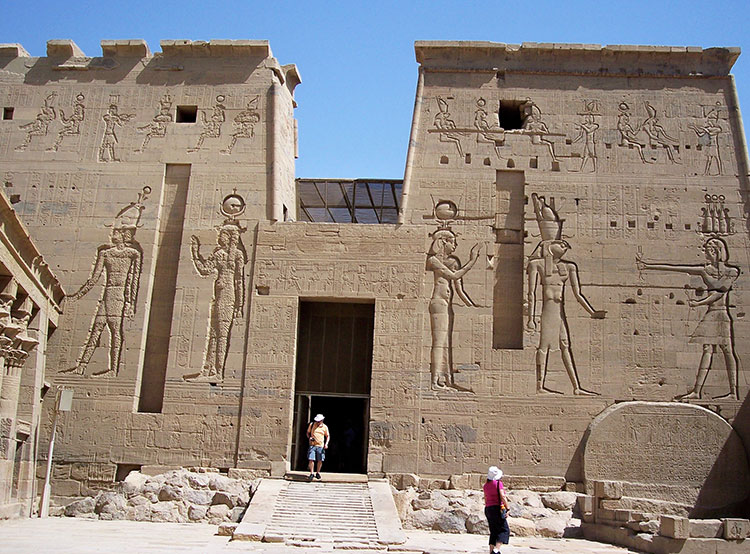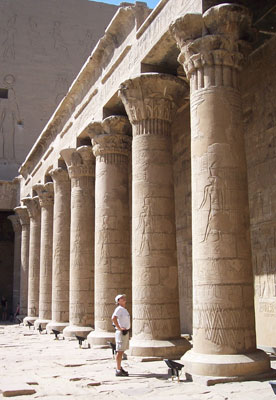Up the Nile from Luxor to Aswan
This item appears on page 66 of the February 2010 issue.
(Part 2 of 3 on Egypt)
The main thrust of my September ’09 Egypt journey was a seven-day/seven-night cruise on the timeless Nile, and the first half of the cruise was upstream, heading south, from Luxor to Aswan.
From Cairo, an easy hour-long flight south transports visitors to Luxor, home port for the majority of the scores of passenger vessels that ply the Nile on four- to seven-day cruises.
Luxor: riverboat central
On the Luxor waterfront, the Crown Prince was waiting for me and 85 other passengers (approximately 55% of the ship’s passenger capacity), mostly in groups from the UK and Germany.
It is a rather typical Nile riverboat with all outside-facing comfortable cabins and a huge, open top deck, which I was able to utilize thoroughly throughout the cruise. Almost all meals served aboard were buffet style, with plenty of options for all tastes, including tasty Middle Eastern vegetarian cuisine, a personal favorite.
On my arrival evening in Luxor I met my guide for the coming week, Morkos. We walked from the dock to the nearby Luxor Temples, whose staggering illuminated columns and expansive grounds date back to Amenhotep and Ramses II. It quickly became clear that I was going to be the beneficiary of all of the ancient Nile history I could digest in the coming week.
Valley of the Kings
The following morning we drove to the Valley of the Kings, whose tombs were ordered by the various kings of the time to be hand carved in the rock walls of the valley. The purpose of undertaking these massive digs was to safeguard the tombs against grave robbers.
We visited several of the 62 tombs that have been discovered to date: the burial chambers of 60 kings and two queens. The elaborate, colorful wall paintings in some of the tombs I visited were remarkably well preserved, especially KV 2, the tomb of Ramses IV. Morkos was able to bring the Valley of the Kings to life with his vivid descriptions of the many nobles who were buried within its still-expanding boundaries.
En route to the Valley of the Kings, we traveled through the local Nile Delta, whose warm climate and rich black soil combine to support a wide array of crops, including tomatoes, corn, wheat, sugarcane, date palms and bananas. Still today, many of the fields along the Nile are hand tilled by local subsistence farmers — a way of life relatively unchanged since the damming of the river nearly a half century ago.
On to Edfu and Kom Ombo
Sailing upstream toward Edfu in the evening, we negotiated the locks at Esna while locals onshore noisily celebrated the end of Ramadan. In Edfu the following day, we toured the finely preserved Temple of Horus, dedicated to the Falcon God. This Greek-style temple is widely considered to be the most finely preserved in Egypt.
In the afternoon we docked at Kom Ombo and enjoyed a carriage ride to the Temple of Kom Ombo. This temple, dedicated to two deities — the double-headed sparrowhawk Haroeris and the crocodile-headed Sobek — features impressive columns and fine examples of early Greek calendars. Upon our return to the ship, we sailed on toward Aswan.
Aswan and the High Dam
The impressive city of Aswan is picturesque and clean and offers a high quality of life to its residents. It seems they even embrace the oppressive summer heat, feeling it keeps city dwellers from the north from migrating south in any numbers. This strategically located city is the site of the Aswan dams and thereby the end point for Nile cruises.
On my first morning in Aswan we visited the quarry-like setting of the Unfinished Obelisk.
We then ventured to the massive, four-kilometer-long High Dam. Morkos informed me about its construction in partnership with the Soviet Union (after such a partnership offer was rebuffed by the US government) during the volatile Cold War period of the early 1960s. Fifty years later the dam continues to supply much of the water and power needs for Egypt’s population.
Lake Nasser, inland sea
Construction of the dam changed the face of Egypt forever. In addition to the creation of a modern hydroelectric miracle, gone was the annual flooding which had both plagued and graced Nile residents over the centuries.
Also created by the High Dam was enormous Lake Nasser, which stretches 150 kilometers upriver through Egypt and another 350 kilometers into Sudan. The crocodile, which once was plentiful on the lower reaches of the Nile, is found there no more, being restricted to Lake Nasser, where they remain plentiful. Until being apprised of this fact, Lake Nasser had appeared, to me, to be an ideal place for a swim.
Later we took a small boat to Agilika Island to visit the inspiring ancient Philae Temples, which were dismantled and then reconstructed on higher ground in a monumental preservation effort. This was just after the construction of the High Dam, which, combined with the old Aswan Dam, resulted in the flooding of the original site.
Nubian village swim time
In mid-afternoon we took another boat ride, this time to a highly scenic, dedicated conservation area just below the dam. We visited a colorful, traditional Nubian village; the descendants of the dark-skinned population were from Sudan. Unfortunately, the village school I was hoping to visit was closed due to the post-Ramadan holiday.
We then stopped, in the heat of the afternoon, at a river beach near the village for a swim in the cool, pure waters of this small, protected slice of Eden. Swimming with the smiling, carefree village children absolutely made my day.
While floating, I observed some foreign tourists riding camels along a ridge above the beach in the beating, 100-plus-degree afternoon heat. I was right where I needed to be.
My Egypt journey was hosted by (ITN advertiser) Value World Tours (Fountain Valley, CA; phone 800/795-1633, www.valuecruises.net), the Egyptian Tourist Authority (www.egyptravel.com) and EgyptAir (www.egyptair.com).
For the seven-day/seven-night cruise of the Nile with Value World Tours, the cruise-only cost is $2,399-$2,999 per person, based on double occupancy.
In part three of this series, I’ll report on Abu Simbel and my return trip down the Nile.
Keck's Beyond the Garden Wall
❝The miracle of water’s transformation of the desert is perhaps nowhere else on this troubled sphere in greater evidence. ❞
— Randy reflecting on the lifeblood of the Egyptian desert that is the Nile


